Exploring the Colors of Precious Stones
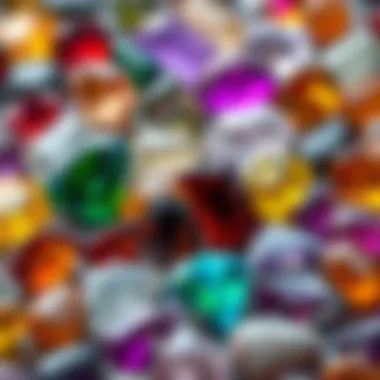

Intro
The enchanting world of precious stones has captivated human beings for centuries, offering a vivid palette of colors that represent more than mere beauty. Colors in gems are not just a feckless whim of nature; they are laden with stories, cultural significance, and economic implications. Understanding the spectrum of these hues is essential for collectors, gem enthusiasts, and those simply curious about what lies beneath the surface of these alluring stones.
This exploration of colors takes us on a journey through the origins of various gemstones, dissecting the chemical and environmental factors that contribute to their unique shades. For instance, the deep azure of a sapphire arises from trace elements of iron and titanium in its crystal lattice. Similarly, the rich red of a ruby speaks to the presence of chromium—a tiny detail that yields a massive impact on market value.
Each color category harbors its own historical tales and cultural meanings, showcasing the importance of social context in how we perceive and value these natural treasures.
A look ahead reveals sections featuring collectible stones, identification techniques, and a nuanced discussion on how color affects market trends. By the end of this article, readers will not only appreciate the vivid colors of these precious stones but also comprehend their intrinsic worth and the complexities that influence their appeal.
Prelims to Precious Stone Colors
The colors of precious stones play a pivotal role in their appeal and value, capturing the imagination of collectors and enthusiasts across the globe. Understanding how color influences the gemstone market cannot be overstated, as it intertwines with aspects of aesthetics, rarity, and even historical significance. Each hue tells a story about the stone's origin, the qualities it embodies, and how those qualities resonate emotionally within different cultures.
Color is not just a superficial characteristic; it reflects the gem's internal structure and provides essential insights into its composition. Various factors, such as light absorption, chemical impurities, and crystal structure, contribute to the rich tapestry of colors we see in these stones.
In this article, we will journey through the colorful world of precious stones, examining their classifications, the science behind their hues, and the cultural context that adds another layer of richness to their significance. This exploration is particularly relevant for rock and fossil collectors, who often seek to deepen their knowledge not just about the geomaterials themselves, but about the stories underneath their vibrant surfaces.
The Importance of Color in Gemology
Color stands at the forefront of gemology, acting as the primary guide when determining the quality and market value of stones. A vivid red ruby, for instance, is often more precious than a lighter, washed-out version. This phenomenon is largely calculated through a gemstone's marketability. Differentiating colors not only influences aesthetics but also impacts rarity and desirability.
The hue, tone, and saturation of colors also play a role, each affecting a stone's desirability in unique ways. For example, a deep blue sapphire from Kashmir may fetch a higher price compared to a lighter-toned counterpart from a different locality. Similar trends can be observed in the world of diamonds, where vivid pinks and intense blues command exceptionally high prices.
Understanding Color: Terminology and Concepts
To effectively appreciate the world of gemstone colors, certain terminology becomes essential. Here are some key concepts:
- Hue – This refers to the actual color of the gemstone, such as red, blue, or green. It’s the first thing we perceive when looking at a stone.
- Saturation – This indicates the intensity or purity of the color. A stone with high saturation has rich, vivid colors, while one with low saturation appears more muted.
- Tone – This refers to how light or dark a color is, affecting the stone’s overall appearance. For example, a light yellow diamond can significantly vary in visual appeal compared to a deep yellow one.
Understanding these color descriptors is crucial for anyone wanting to dive deeper into the gem market. When collectors gain familiarity with these terminologies, it enhances their ability to assess stones and make informed purchasing decisions.
In summary, the exploration of colors in precious stones is not merely about aesthetics; it involves a fascinating interplay of science, culture, and economic factors. As we delve further into this exploration, we will uncover more layers that contribute to the significance of these radiant gems.
"Colors are the smiles of nature." – Leigh Hunt
For additional reading on the subject, check out Britannica's exploration of gemology, where the foundational principles about color and its significance are discussed in greater detail.
The Science of Gemstone Colors
Understanding the science behind gemstone colors is essential for both gem enthusiasts and collectors alike. Color serves not only as a visual spectacle but also as a fundamental criterion in establishing the value and rarity of precious stones. In this section, we explore the genesis of color in gems and the various external factors that play a role in shaping these vibrant hues. The intricacies of this subject matter enrich our appreciation and knowledge, making it clear that color is far from merely ornamental.
How Color Forms in Minerals
Colors seen in gemstones arise primarily from the way light interacts with minerals at a molecular level. When we consider how a gemstone like a ruby gets its red hue, it’s mainly about the presence of chromium within the corundum structure. This element absorbs specific wavelengths of light while reflecting others, effectively generating the appealing red we see.
On the contrary, sapphires, which are essentially the same mineral as rubies, can take on an array of colors depending on what trace elements are present. A sapphire can be blue, yellow, or even pink. The variations come down to different impurities: iron and titanium can yield a rich blue, while other combinations may produce its famous golden hues.
Here are some key points to keep in mind about color formation in minerals:
- Trace Elements: Elements like chromium, iron, and manganese can take a crystal from dull to dazzling.
- Structural Defects: In some cases, the arrangement of the crystalline structure can cause color changes or intensity variations.
- Temperature Conditions: Formation temperature can greatly influence the color, with cooler environments sometimes yielding more intense colors.
Influence of Environmental Factors
The environment where gems form plays a crucial role in their coloration and variety. Factors such as temperature, pressure, and surrounding mineral content can dramatically alter the final appearance of the stone. The most fascinating twist is that two gems formed in different localities can look completely distinct—not just in color, but in clarity and overall appeal as well.
- Geological Settings: Different geological formations contribute to unique colors. For instance, garnets formed in metamorphic rocks versus volcanic environments can showcase significantly different colors and clarity qualities.
- Mineral Interaction: The relationship between different minerals can affect how colors manifest within a gem. For example, the presence of iron alongside specific minerals can lead to unique shades of green.
- Exposure to Elements: Over time, exposure to light, air, and water can lead to surface effects that change the perceived color of gemstones. Such transformations can add a layer of depth to otherwise stable colors.
The environment shapes not only the colors but also the stories behind these precious stones. Understanding their origins can significantly enhance its allure.
In essence, the science of gemstone colors is a complex interplay between chemistry and the environment. By digging into the origins and influences on these hues, collectors can better understand the intrinsic value that color adds to precious stones.
Classification of Precious Stones by Color
When it comes to precious stones, color is king. The hues that gems display can be as varied as a painter's palette, each shade telling a story that reflects its origins, the minerals in play, and even the cultures that treasure them. Classifying precious stones by their colors not only enhances our understanding of these gems but also adds layers of meaning to their value and allure. From the fiery reds of rubies to the deep blues of sapphires, each classification opens a window into a world rich with history and significance.
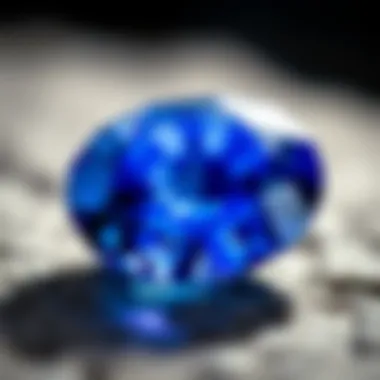
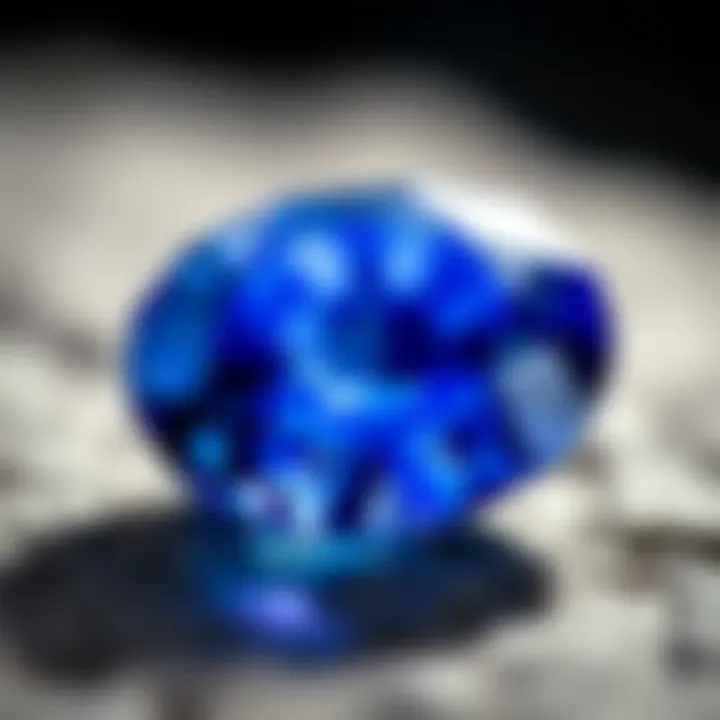
By categorizing stones based on coloration, we not only ease the purchasing journey for collectors but also foster appreciation for the artistry nature has shared with us. This section aims to delve into the specific colors that precious stones can embody and discuss the unique characteristics tied to each category.
Red Precious Stones
Red stones exude an intensity that can hardly be matched in the gem world. When we think of red, the ruby often comes to mind first. Considered a symbol of love and passion, rubies can vary from bright crimson to deeper shades tinged with pink.
- Ruby: Famous for its vibrant hue, rubies are often adorned in jewelry that celebrates love and courage. Their color comes from chromium; the more chromium present, the richer the color.
- Garnet: While garnets can range across a spectrum of colors, the deep red varieties evoke a sense of warmth. They are often associated with trust and loyalty.
Collectors looking for these gems should keep an eye on clarity and cut, as these factors greatly enhance their appearance and value.
Blue Precious Stones
When we gaze upon blue gems, we often find ourselves transported to tranquil waters or a clear sky. Notably, sapphires dominate this category, showcasing incredible variations in shade.
- Sapphire: The quintessential blue gemstone comes in hues from cornflower blue to deep indigo. Notably, their origin influences the color’s depth; for example, sapphires from Kashmir tend to command higher prices due to their vibrant appeal.
- Aquamarine: Light blue to blue-green in hue, aquamarine is often likened to the sea itself. Beyond its beauty, it has maritime folklore attached to it, seen as a talisman for sailors.
While seeking blue gemstones, look for even color distribution and the absence of inclusions that can disrupt their visual flow.
Green Precious Stones
Green stones speak of nature and vitality. The lush greens reminiscent of springtime can inspire a sense of renewal and hope.
- Emerald: Known as the stone of rebirth, emeralds can display a range of green shades. Their enchanting glow is due largely to traces of chromium and vanadium. Notably, the deeper the green, the more valuable they become, although inclusions known as "jardin" in emeralds are common and expected.
- Peridot: A bright olive green, peridot is often associated with light and positivity. It is one of the few gemstones that come in one color, though the shade can deepen with size.
In this category, collectors should pay attention to the vibrancy and saturation of the green, as those factors can significantly elevate their worth.
Yellow and Orange Precious Stones
Yellow and orange stones radiate joy and warmth, reminiscent of sunlight on a summer’s day. This color spectrum is less traditional among precious stones but still captivating.
- Citrine: Often hailed as the "merchant's stone," citrine's vibrant yellow-orange hues evoke happiness and abundance. Often confused with topaz, citrine's vibrancy can vary greatly depending on its source.
- Fire Opal: With fiery orange and red shades, fire opal captivates collectors with its unique play of color, reminiscent of flames.
Collectors should be wary of treatments that some of these stones undergo to enhance their color.
Purple Precious Stones
Purple, often thought of as royal, carries connotations of luxury and power. This color group showcases several intriguing options for collectors.
- Amethyst: Widespread and admired, amethyst's various shades of purple, from light lilac to deep violet, are widely coveted. It’s the February birthstone and symbolizes peace and clarity of mind.
- Iolite: Sometimes called the "water sapphire," iolite shifts colors depending on the angle it is viewed, adding complexity to its purple hue.
It's essential to examine the clarity and depth of color, as richer, deeper shades often draw higher prices.
Colorless and White Precious Stones
Colorless or white stones may lack the pop of color, but they exhibit a clarity and brilliance that can be stunning in their own right.
- Diamond: The epitome of glamor and luxury, colorless diamonds can be truly mesmerizing. The factors of cut and clarity play a critical role in defining their beauty and value.
- White Sapphire: An excellent alternative to diamonds, white sapphires often have a subtle sparkle that can add an elegant touch to any piece of jewelry.
Though less populated in terms of color, the quest for clarity and cut quality can yield stunning results for collectors looking for less conventional options.
In summation, classifying precious stones by their colors does more than just help in identification; it establishes a framework for appreciating their beauty, storytelling, and value. The tones and shades inform us about their origins and influence our choices as collectors, guiding us toward what resonates with our personal tastes.
Sourcing and Localities of Colored Stones
The sourcing and localities of colored stones represent a vital aspect of gemology that enriches our understanding of these precious materials. In exploring various gemstones, knowing where they come from not only elevates our appreciation of their beauty but also adds layers of meaning to their significance. Each locality holds its own stories, traditions, and unique environmental factors that affect gemstone properties.
Moreover, knowing the source can impact value. Gems sourced from famed localities often command higher prices due to their rarity and historical significance. Before modern gem sourcing practices, the geographical origin was usually a top consideration when buying. Today, this practice remains paramount for collectors and enthusiasts alike who seek authenticity and provenance in their stones.
Famous Gem Localities for Color
Certain regions around the world have become synonymous with specific colored gemstones, creating a reputation that truly sets them apart. For instance:
- Kashmir: Renowned for its spectacular blue sapphires, Kashmir is considered one of the premier sources of this gemstone. The pronunciation of its name evokes visions of deep, velvety colors that captivate gemstone aficionados.
- Colombia: The emeralds from Colombia, especially those from the Muzo mines, are lauded for their vivid green hues and internal clarity. It's said that no other emerald can match the depth of color found in Colombian stones.
- Myanmar: Known for rubies, particularly the intense red rubies from the Mogok valley, these gems are among the most sought after in the jewelry market.
- South Africa: The birthplace of diamonds, South Africa has also produced stunning tanzanites from its vibrant mines, showcasing an alluring spectrum of colors.
These localities contribute greatly to the identity of the stones they produce, making them highly desirable within the collector's community.
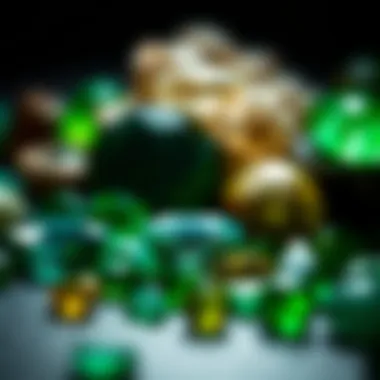
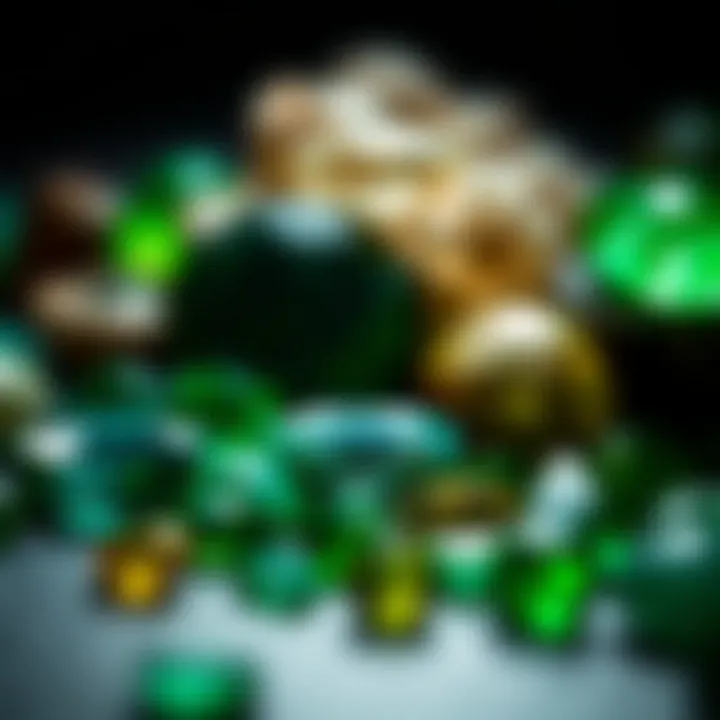
Geographic Influence on Color Variations
The geographical location of gemstone deposits plays a crucial role in shaping color variations. Factors such as mineral composition, temperature, and the presence of trace elements can dramatically influence the hues of the stones. For example, the presence of chrome can turn a garnet from a dull brown to an appealing green, as seen in chrome garnets.
Environmental conditions also play a role. Stones that form in volcanic environments or metamorphic conditions often exhibit different characteristics when compared to their counterparts formed in sedimentary regions. Take the vibrant blue of the Larimar stone, only found in the Dominican Republic; it is the result of specific geological processes unique to its locale.
The interplay between geology and gemstone coloration is paramount in understanding why certain colors are reproduced in particular regions.
Additionally, some gemstones, like opals, showcase a unique play-of-color effect that varies not only with light but also with their origin. The Australian opal, known for its bright flashes of color, reflects the specific conditions that foster its formation along its geologic timeline.
Cultural Significance of Colors in Gems
The vibrant hues of precious stones extend beyond mere aesthetics; they are deeply interwoven with cultural meanings and historical context. In this section, we explore how the colors of gems have often reflected societal values, beliefs, and even religious sentiments across various cultures. Understanding this connection can offer collectors and enthusiasts richer insights into the stones they admire, as well as elevate their appreciation for these natural wonders.
Historical Associations with Color
Throughout history, colors in gemstones have held significant weight. For instance, the rich red of rubies has long been associated with power and royalty. Kings and queens traded kingdoms like marbles for these stones, believing the fiery gemstone could foster strength in battle and ensure victory. Similarly, emeralds, with their lush green tones, symbolized fertility and rebirth in ancient civilizations, particularly among the Incas and Egyptians.
In many cultures, certain colors convey not just beauty, but deeper meanings. For example, in Indian culture, yellow stones like canary diamonds are considered auspicious, believed to bring prosperity and positivity to life. Conversely, black stones like onyx can be viewed as ill-omened in some contexts, while in others, they symbolize protection and grounding.
"The color of gemstones is not just a visual dramatic; it paints the canvas of history and belief systems."
Here are some notable historical associations of colors in gems:
- Green (Emerald): Connected to luck and fertility in Egypt.
- Red (Ruby): Regarded as the stone of love and passion in many ancient civilizations.
- Blue (Sapphire): Often linked with wisdom, divine favor, and nobility.
These associations have influenced purchasing decisions throughout ages and cultures, allowing gemstones not just to be adornments but also representations of identity and societal values. Understanding these historical contexts can enrich the narrative behind an individual's collection, providing layers of appreciation.
Symbolism and Cultural Values
Colors in gems also hold symbolic weight, often encapsulating cultural values that transcend generations. For example, in many parts of the world, white stones, particularly diamonds, symbolize purity and commitment, making them the quintessential choice for engagement rings. This symbolism originally stemmed from the notion that diamonds were indestructible, much like the bonds formed by marriage.
Similarly, the blue hue of lapis lazuli held great significance in ancient Mesopotamia, often representing the heavens. Its deep, celestial color not only adorned the attire of the elites but was also used in artifacts meant to bridge earthly existence with divine essence. This reflects how colors can act as cultural signifiers, revealing much about societal hierarchies, beliefs, and aesthetic preferences.
From a sociological perspective, gemstones are also valued based on the colors considered desirable in specific cultures. For instance, in a modern context, the expanding market for colored diamonds has seen significant growth, showing that consumers are increasingly appreciating uniqueness and individuality in their pieces.
In summary, the cultural significance of gemstone colors can deeply impact their desirability and meaning, serving not only as beautiful adornments but as powerful tools of expression and identity for collectors globally. Understanding these facets allows one to navigate the intricate world of gem collection with a more informed perspective, enriching both appreciation and investment in these radiant treasures.
Explore more about the historical significance and symbolism of gems at Britannica and delve into collector discussions on Reddit.
The Market Value of Color in Precious Stones
The valuation of precious stones is intricately tied to their colors. In gemology, color is not just a superficial attribute but a decisive factor that influences desirability and market potential. The vibrant shades that gems exhibit can often make or break their price on the market. For collectors and investors alike, understanding the dynamics of color in gemstones can provide a significant edge.
Color and Rarity: Impact on Pricing
The relationship between color and rarity is straightforward yet profound. Some colors are elusive, making them rarer and, consequently, more valuable. For instance, a deep blue sapphire from Kashmir is not merely valued for its aesthetic appeal but also due to its limited supply. This scarcity can drive prices sky-high, especially when comparable stones with lesser hues flood the market.
Rarity can also be affected by the stone's origin. Certain colors can be tied to specific localities, leading to a premium. Consider the vivid green of the Colombian emerald, which has secured a special status among gemstones. On the flip side, colors that are common, such as pale yellow diamonds, typically fetch lower prices on the market.
Moreover, the grading of color in gemstones follows specific criteria, typically based on hue, tone, and saturation. A deeper understanding of these standards helps buyers make informed decisions, ensuring they get the best bang for their buck.
"The color of a gemstone is its first impression; the clarity of its hues can enchant or deter a potential buyer."
Trends in Color Demand
Color preference in gemstones is not static, but instead, subject to whims of fashion and societal influences. In recent years, certain hues have surged in popularity, causing shifts within the market. For instance, the rise of interest in lab-grown gems has introduced new shades and variations that weren't traditionally popular. Millennial consumers often lean toward unique colors, sometimes opting for more unconventional choices like lavender sapphires or teal tourmalines.
Social media platforms can also play a pivotal role in shaping color demand. A stunning photo of a vivid purple amethyst might go viral, leading to increased interest in that specific shade, thereby raising its market value.
In contrast, classic colors like red rubies and blue sapphires maintain a steady demand, rooted in their historical significance and timeless appeal. However, these established hues are now often evaluated in new contexts, as buyers look for distinctive variations that set their collections apart.
Thus, keeping an eye on emerging trends and understanding evolving consumer preferences can be the key to navigating the gemstone market successfully. Whether a collector is targeting high-value investments or simply expanding a personal collection, color remains a central pillar worth noting.
The Role of Treatments in Gem Colors


When we dive into the world of precious stones, the impact of treatments on their color cannot be overstated. In the gem industry, treatments often transform a stone's appeal and value. Understanding these enhancements is crucial for collectors and enthusiasts alike, as they directly affect authenticity and market performance.
Natural vs. Treated Stones
The distinction between natural and treated stones is foundational. A natural stone is formed through geological processes over millions of years, emerging from the earth with its unique color characteristics. In stark contrast, treated stones have undergone modifications designed to improve their color, clarity, or overall appearance. While some treatments are merely enhancements, others can significantly change how a gem is perceived in the marketplace.
For example, consider a sapphire. A naturally occurring sapphire may exhibit a rich, deep blue, but if treated with heat, it can achieve an even more vibrant hue. This manipulation raises a pertinent question for collectors: how does one ascertain the stone's authenticity? It’s essential to vet the source, as the presence of treatments can influence both sentimental value and price likelihood.
- Natural stones often command higher prices due to their scarcity.
- Treated stones can come with reduced value if the treatment is common or seen as less desirable.
Common Enhancement Techniques
A number of enhancement techniques exist in the gem world, each with its implications. Here are a few notable methods:
- Heat Treatment: This popular method affects color and clarity. Many sapphires and rubies are treated this way to enhance their vibrant shades.
- Irradiation: This technique is primarily used for diamonds. Here, stones are exposed to radiation to obtain a rare color like fancy blue or pink. Its appeal lies in the extraordinary aesthetics it creates.
- Dyeing: Often employed for jade and quartz to achieve intense colors. This treatment involves injecting dyes into the stone, which can alter natural tones. Collectors should approach dyed stones with caution as these hues may fade over time.
"Knowledge is the bedrock of a collector’s arsenal. A well-informed choice makes for a wise acquisition."
- Oiling: Common in emeralds, oiling enhances clarity by filling surface-reaching fractures and increasing transparency. Yet, this process can impact durability and requires periodic maintenance.
The gem industry’s reliance on these treatments means that collectors must do their homework. Familiarity with various enhancement techniques allows for more informed purchasing decisions. It's a blend of science and art, with each treatment serving a purpose in elevating the stone’s visual appeal.
As one navigates through the vibrant hues of gemstones, it's essential to recognize that while enhancements can amplify beauty, they also invite a deeper scrutiny of authenticity and worth.
Exploring Color Perception in Gems
Understanding how we perceive colors in gemstones is not just a matter of aesthetics; it plays a vital role in how these gems are valued and appreciated. Color perception can trigger emotional responses and influence decisions when it comes to purchasing or collecting these valuable treasures. For enthusiasts and collectors alike, understanding this dimension provides deeper insights into both the physical and emotional worth of precious stones.
The Psychology of Color
Colors can evoke powerful feelings and associations; they tell stories beyond their visual appearance. For instance, warm hues like reds and oranges often bring about a sense of excitement or urgency, while cooler colors like blue and green tend to evoke calmness and tranquility.
In the realm of gemstones, this psychological connection becomes evident. For example, a vibrant ruby might be associated with passion and vitality, making it particularly desirable among those seeking to express love or strength. Conversely, the serene blue of a sapphire could be favored by individuals who value peace or stability in their lives.
The understanding of color psychology can affect not just personal choices but also market trends. When colors resonate more strongly with cultural values or personal sentiments, the demand for those particular stones often rises; collectors might gravitate toward sapphires during a cultural trend emphasizing harmony or towards garnets in times when passion is being highlighted in fashion.
Influence of Lighting on Color Appearance
Lighting significantly affects how we perceive the color of gemstones. The same stone can appear dramatically different under various light sources. For example, a diamond could look more colorful under warm, incandescent lighting, bringing out its fiery brilliance. In contrast, harsh fluorescent lights might wash out its hues, making it appear more colorless.
Moreover, the concept of the metameric effect comes into play here; certain stones may match in color under one lighting condition but look entirely different under another. This can be particularly important for collectors when assessing the quality of a gem.
When displaying or purchasing gemstones, understanding how different lights interact with the stone is key. Here are a few common types of lighting and their effects on color perception:
- Natural Light: Often regarded as the best for truly assessing color. It can show a gem’s colors in their full glory without distortion.
- Incandescent Light: Adds warmth, enhancing reds and yellows while potentially muting blues and greens. Useful for assessing warmth in stones like citrine or garnet.
- Fluorescent Light: Tends to brighten colors but might also flatten them out. This lighting can be tricky for evaluating more muted stones.
- LED Lighting: The newest entrant, having a mix of qualities from the above types, with adjustable spectrums that can highlight certain facets while hiding others.
To wrap it up, the interaction between color psychology and lighting gives depth to the appreciation of gemstones. It's not just their physical nature that enchants collectors; it’s also the intangible feelings they stir and the magical way they perform under different lights. The nuance in color perception opens a world where precious stones take on lives of their own, captivating our hearts and minds.
Ending: The Endless Fascination with Color
As we wrap our exploration of precious stones and their mesmerizing colors, it's clear that color is not merely a superficial characteristic; it is a fundamental aspect that drives interest, value, and appeal. The spectrum of colors found in gemstones speaks to both the science of nature and the human experience, influencing collectors, jewelers, and enthusiasts alike in profound ways.
The journey through the vibrant hues of gemstones reveals many layers. Each shade—be it a deep ruby red or the soothing tones of aquamarine—carries its own narrative shaped by environmental conditions, geological history, and the cultural significance ascribed to it. This complexity contributes to an understanding of why certain colors are pursued with such fervor by collectors.
Not only does color define the aesthetic allure of a gemstone, but it also plays a critical role in determining its market value. As discussed in previous sections, the rarity of specific colors, coupled with trends in demand, shapes pricing in the gemstone market. In the mind of the savvy collector, knowledge of color is an invaluable tool; it is the key to making informed decisions about acquisitions that will not only enhance their collection but also potentially serve as wise investments.
Cultural associations with colors add yet another layer of depth. Every gem carries whispers of symbolism; we can think of how sapphire is tied to wisdom and fidelity, while emerald is often linked to rebirth and vitality. Understanding these connections enriches one's appreciation and appreciation of the stones.
"The beauty of colored stones is akin to a rainbow trapped in mineral form, each hue telling its own story, awaiting to be unearthed by those who recognize its worth."
Future Directions in Gemology and Color Study
Looking ahead, the exploration of color in gemstones is poised for exciting developments. Scientific advancements continuously enhance our understanding of how colors present in minerals can be altered or enhanced. The advent of technology enables jewelers to experiment with color enhancement techniques responsibly, sometimes leading to new gemstone varieties with striking colors that were not previously accessible.
Moreover, interdisciplinary studies integrating fields like psychology and environmental science may provide fresh insights into how humans perceive and value color. Research into color perception will likely deepen, helping collectors understand not just market trends, but also the emotional aspects tied to specific hues.
In an environment where sustainability is becoming increasingly important, the future will possibly see a greater emphasis on ethical sourcing and treatments that respect both the environment and the culture from which these gems originate. By focusing on responsible practices, the gemstone industry can continue to thrive while honoring the natural artistry born from within the Earth’s crust.
As collectors and enthusiasts, embracing the colorful narrative of gemstones can enrich our appreciation, connecting us to historical context and future trends that shape the industry. Such understanding fosters not just knowledge but a deeper passion for the treasures we cherish.
In summary, the fascination with colors in precious stones is a journey without end. Each gemstone invites us to explore its individual story, offering insights into nature’s artistry and humanity’s quest for beauty. The vibrant spectrum is not only a delight to the eyes but also a compelling testament to the intricate dance between color, culture, and value.



